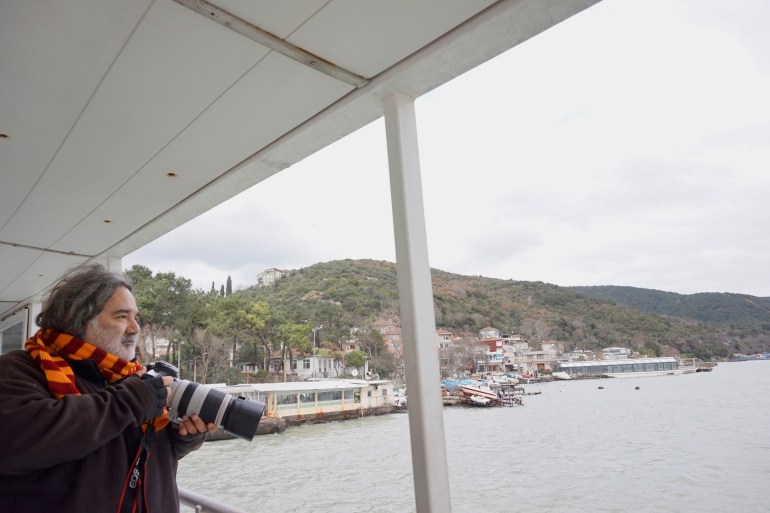Istanbul, Turkey – A light snow falls on Istanbul as Yoruk Isik boards a ferry and climbs upstairs, passing up the cosy enclosed lower deck where tourists and commuters sip tea for the open-air top of the small boat.
As the ferry embarks on its trip up the Bosphorus Strait, Isik pulls out a camera and begins snapping photos of a giant southbound cargo ship he recognises, one usually contracted to carry wheat purchased in Eastern Europe as humanitarian aid for Yemen.
Hundreds of ships ply the strait each day, from giant oil tankers and container ships that dwarf the Ottoman mansions and mosques on the shore to naval destroyers and submarines moved around the world like pieces on a giant chessboard.
The 50-year old Istanbul-born geopolitical analyst and ship-spotter always carries a camera and is constantly on the lookout for warships and civilian vessels he says are involved in “curious activities”.
“When you are living your life in Istanbul, there is a sublayer of these events happening literally right next to you and most of these Istanbul residents, in their busy day, are not so aware of it,” Isik said.
Vessels registered in places with unstable governments, or where authorities are known to not inspect cargo well, pique the interest of ship-spotters, as do those who seem to drop off the radar in heavily trafficked areas in the Mediterranean Sea. By keeping track of their movements, Isik and other ship-spotters are often able to predict new conflicts before global superpowers publicly announce them.
His target on this day is a Russian Tapir-class naval landing ship, capable of carrying hundreds of troops and armoured vehicles, one of several that regularly make the trip from Russian Black Sea ports south to a Russian base in Tartus, Syria. Russia’s naval bases in the Black Sea are crucial warm-water ports for its projection of power, not only in Syria but far afield in conflicts in Libya and Mali.
 By keeping track of ship movements, Isik and other ship-spotters are often able to predict new conflicts before superpowers announce them [Umar Farooq/Al Jazeera]
By keeping track of ship movements, Isik and other ship-spotters are often able to predict new conflicts before superpowers announce them [Umar Farooq/Al Jazeera]As Russia seems to be gearing up for a possible war in Ukraine, one obvious question is whether that means Moscow is paying less attention to its other global engagements, a shift Isik says would be reflected in fewer ships going south through the Bosphorous. That same logic can be used to determine how Ukraine and its NATO allies are preparing for war, and how many ships are being sent north into the Black Sea.
“I constantly follow any military ships going to Ukraine, to see who is sending what message,” Isik said. “So, if a French ship is coming after US ships, it shows that in NATO there is some harmony, because the American ship leaves the Black Sea and, that same night, a French ship enters.”
Spying on superpowers
The internet has made it much easier to find and track movements through waterways like the Bosphorous. Short-range terrestrial radars dot the shores of most of the world’s coastlines, picking up identification signals from passing ships as part of an international effort to avoid sea collisions.
On his smartphone, Isik can pull up several applications that gather that data, showing the names and locations of many vessels around him. But military ships don’t always turn their transmitters on, so Isik has to get creative: checking public webcams installed along coasts, or Instagram or other visual social media posts that often coincidentally include warships crossing in the background.
In 2021, for instance, ship-spotters noted 50 Russian warships going south to the Mediterranean and 43 north to the Black Sea. Thirteen US warships went to the Black Sea, while 12 left it for the Mediterranean.
 A Turkish engineer stands on a platform over tunnels submerged in the Bosphorus [File: Tolga Bozoglu/EPA]
A Turkish engineer stands on a platform over tunnels submerged in the Bosphorus [File: Tolga Bozoglu/EPA]The most obvious sign of an approaching Russian warship, though, is the appearance of Turkish Coast Guard boats. Just before sunset, they show up at the entrance to the Bosphorous to escort the Russian landing ship, with armoured personnel carriers on deck, through Istanbul on its journey south to Syria.
It is part of Turkey’s role in policing the strait, laid out in the 1936 Montreux Convention, which gives Ankara control over the Bosphorous and the Dardanelles to the southwest – both passages must be crossed by ships that want to move from the Black Sea through the Sea of Marmara to the Mediterranean, and back.
The convention puts limits on the warships states who do not border the Black Sea can send through the Bosphorous: each ship must weigh less than 15,000 tonnes, and the total weight of their ships in the sea cannot exceed 45,000 tonnes. Non-Black Sea states must notify Turkey 15 days ahead of their planned transit, and cannot stay in the sea for more than 21 days.
The six states bordering the Black Sea – Turkey, Russia, Bulgaria, Romania, Ukraine and Georgia – operate more freely, only notifying Turkey eight days in advance of transit. All states are barred from sending through aircraft carriers, as well as submarines that are being deployed to a conflict.
Unless there is an open war, Turkey must allow Black Sea powers to transit, which often means states it is indirectly at war with freely use the route.
‘Snipers on the deck’
In 2015 – before Russia openly said it was jumping into the Syrian war on the government’s side against Turkey- and Western-backed rebels – Isik began noticing both civilian and military vessels carrying equipment to Syria.
“Russia had started quickly and they could not get enough military ships, so they used civilian ships. Sometimes the Russians would forget to cover up what they were carrying, so the covers would flap in the wind, and you see what’s there.”
By the end of 2015, Russia had deployed fighter aircraft to Syria and Turkey shot one down for crossing over into Turkish airspace, threatening all-out war. Soon after, Isik noticed a Russian warship with an unusual weapon on the deck.
“These are military ships so they have their own guards, usually snipers on the deck,” he said. “But this time, there was a soldier, holding an anti-aircraft missile, pointing it at the city as the ship went down the Bosphorous.”
Sailor on #ЧМФ Tsezar Kunikov poses with his MANPADS-possible 9K38 Igla-on the Bosphorus #UNPROFESSIONAL @mod_russia pic.twitter.com/nIevYjcUBj
— Yörük Işık (@YorukIsik) December 4, 2015
Turkey sent a rare diplomatic warning to Russia over that incident but as time went on, Ankara and Moscow began cooperating in Syria, a pragmatic deal that still remains in place.
In 2016, Isik started noting the regular transit of Russian-flagged fuel tankers such as the Mukhalatka, which would dock at ports in the Black Sea known for providing jet fuel, then head south claiming to be destined for Lebanon, but then disappear from radar. Years later, Isik got a call from Danish journalists, asking about his photos documenting the Mukhalatka’s transits.
It turned out a major Danish company had sold about $100m worth of fuel to the Russians for use in Syria in at least 33 transactions, conducting ship-to-ship transfers of the fuel in the Eastern Mediterranean, where the Mukhalatka’s transponder was turned off.
Last December, a Danish court handed a four-month suspended sentence to the company’s CEO and a $5m fine for violating EU sanctions on Syria.
Ship of Interest:Russia flag tanker Mukhalatka transits Bosphorus.Supposedly Beirut-bound but likely going to Tartus pic.twitter.com/7zDQ6FpdFH
— Yörük Işık (@YorukIsik) June 2, 2016
Lately, Isik has been following Iranian ships that he thinks seem to be drawing Israeli air attacks on the Syrian port of Latakia. The Shiba and Artabaz, both on a US sanctions list for their use by the Iranian military, regularly travel between ports in the Black Sea, Europe, and Syria.
“Now, twice we see that when an Iranian ship comes to the port of Latakia, exactly where it stands, and most likely exactly where it unloaded container boxes, the Israeli Air Force hits those specific boxes,” said Isik.
Last December, Israel bombed docks where the ships unloaded containers in the port of Latakia. The air attacks, Isik says, are likely the latest incidents in a shadow war between Israel and Iran, one that used to involve attacks on vessels in the Mediterranean, and meant to disrupt the flow of weapons bought in Eastern Europe for Iranian proxies in Syria or Lebanon.
“So if you follow the Iranian ships, you see they were first being hit in the waters, and then twice in Latakia where they docked, so what is going on? Israel is trying to send a message, a part of its extended diplomacy: I have this firing power, and I can back my words with some force.”
Turkey’s geographic reality
Aside from the obvious security implications of a war with Russia, Turkey has other reasons to not interfere in a war over Ukraine. Millions of Russian tourists visit Turkey each year, and most of Turkey’s natural gas is imported from Russia.
Rebuffed in its requests for anti-aircraft missiles from the United States, Turkey bought Russian S-400 missile systems. And in northern Syria, US soldiers have largely pulled out, and Ankara has instead entered agreements with Russia on how to police its border.
Turkey has sold armed drones to Ukraine, but since then has offered itself as a mediator in Kyiv’s conflict with Moscow.
Even if the Ukraine crisis evolves into a larger war, Turkey is not likely to forgo the restrictions on NATO warships set out in the Montreux Convention, said Huseyin Bagci, who heads the Ankara-based Foreign Policy Institute.
Bagci points out that in 2008, as the US sought to show support for Georgia in a war with Russia over South Ossetia, Turkey initially refused to let three American military ships carrying aid through the Bosphorous, saying they were warships and subject to the Montreux Convention. And Turkey did not join its NATO allies in imposing sanctions on Russia after its previous conflict with Ukraine began in 2014.
“The tonnage of ships is subject to the treaty, so beyond that none of them are allowed to pass through unless Turkey says ‘yes’,” said Bagci. “But that is a political decision, and I don’t think Turkey would allow this.”
Scrapping Montreux altogether is not a viable option, given the protection it gives Turkey from Russia, says Ben Hodges, former commander of US Army forces in Europe. Russian submarines, for instance, are ostensibly barred from using the straits to deploy to combat missions.
“The fact that our ally Turkey has sovereignty over the straits is something that helps, frankly, provide stability and security, because Russia has to comply with certain aspects of it is as well,” Hodges says.
NATO could come up with creative solutions to shoring up the naval capabilities of countries such as Ukraine and work to mend its ties with Ankara so it can feel more confident in its dealings with Moscow, Hodges feels.
“We haven’t appreciated the importance of the entire Black Sea region. Walk into any command centre in Europe and the Black Sea will be in a bottom corner on the map,” says Hodges.
“If we did appreciate it, we would be thinking differently about Turkey, and not getting so focused on the current government there, and think longterm about the geography… I think if we did that we would have a better relationship with Turkey, and Turkey would be more confident that if they push back against Russian activities, they would not be left vulnerable.”












